Travel and flyfishing in the Russian Far East
Русский
Rare fish (Salmoniformes) of the
Russian Far East
Charrs of the Elgygytgyn Lake
(Central Chukotka)
Mysterious Elgygytgyn Lake has meteorite origin and the age about 3.5 million years. The lake is very cold
(1 - 3*C only) and deep (180 m). The water is extremely clear - the transparency
is up to 40 meter. In the lake dwell 3 species of unique charrs, two of which
are endemic species. These two charrs
have got into the hands of scientists not long ago (1979 & 1985). They were described as species
new for science, and one of them - as a new genera of salmonids (Salvethymus).
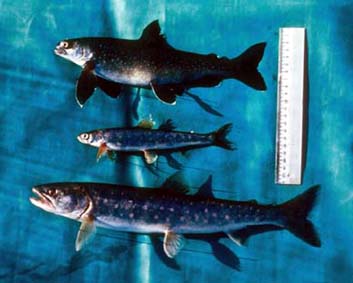
Charrs of the Elgygytgyn Lake:
longfin charr
smallmouth charr
Boganid charr
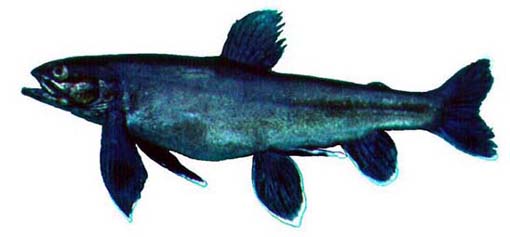
Longfin charr
(Salvethymus
svetovidovi)
Longfin charr
is the most ancient
form of
all charrs. This fish is spending its whole life at the depths of over 80
meters; only in rare cases it comes close to the lake shore. Longfin charr is a
slow growing species - it is reaching about 30 cm in the age of 30 years. This
rare charr is feeding mostly by the zooplankton near the lake bottom - a really unique
ecological niche!
Smallmouth charr (Salvelinus elgyticus)
This small charr is rarely heavier
than 100 g. Its growth speed is extremely low - the maximum age of
this little fish can be over 25 years. Smallmouth charr is feeding exclusively by
zooplankton. It is making daily migrations along the steep slopes of the lake hollow.
It is spending the daytime at the depth about 100 meters, and at night it often comes
close to the leeward shore.
These two plankton-eating charr
species are food of the big predatory charr -
Boganid charr.
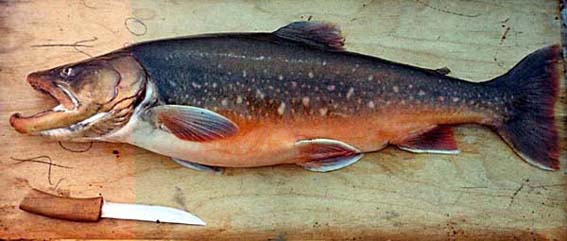
Except the Elgygytgyn Lake, Boganid
charr was found in some other lakes of Chukotka, and at the Taimyr peninsula
(Central Siberia). In the lakes of Chukotka this fish can be over 10 kg. In
the Elgygytgyn Lake Boganid charr is feeding mostly at the big depth. To digest
the food, this fish is often coming close to the lake shore or to the mouths of
small inlets, where the water is several degrees warmer.
American grayling
In some small drainages close to the
Bering Strait there are stocks of the American subspecies of Arctic grayling
(Thymallus arcticus signifer).
This is the same form which is found in many of the waters of North America.
This fish is quite different from the common in northern Asia
east-siberian subspecies of the Arctic grayling. The
T. a. signifer has a rather small dorsal fin with dotted patterns (T. a. pallasi
has stripes), and its tail and caudal fin are not red.
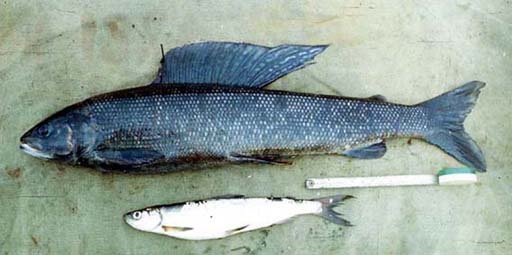
American grayling and least
cisco (Koolen Lake, Eastern Chukotka)
Penzhina cisco Coregonus subautumnalis
This rare
whitefish is found only in two drainages - Penzhina and Talovka (north-eastern
corner of the Sea of Okhotsk)
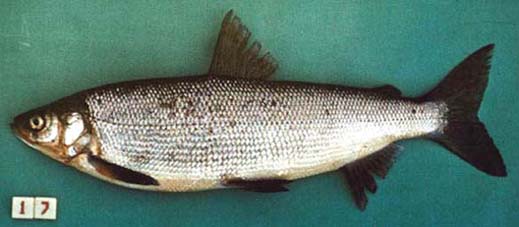
Penzhina cisco
(photo - I.Chereshnev)
Levanidov's
charr (Salvelinus
levanidovi)
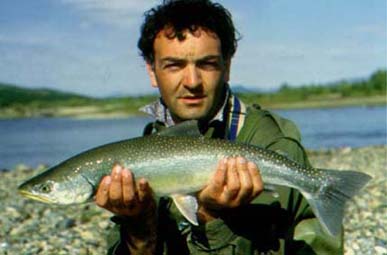
Levanidov's
charr (yellowmouth charr) is found only in 3 drainages at the coast of the Sea
of Okhotsk - in Yama, Takhtoyama & Penzhina Rivers. This is an anadromous
species, which doesn't have any resident forms. This charr is quite different
from all other charr species by the absence of the external difference between
males and females. Biology of this charr is rather similar to the Dolly Varden
charr, but the new species is a more predatory fish. It is easier to catch it
with streamers and more difficult - with a dry fly.
Sea-run (Sakhalin) taimen
Parahucho perryi

Sea-run taimen
is known as the most ancient salmonid fish - possibly, the
age of the species is 40 million years! This predator can be over 200 cm long
with a weight over 70 kg. The species' range is small and includes some
Asian-Pacific islands, situated in temperate climate (Sakhalin, Kurils &
Hokkaido). At the mainland this fish is found in some of the rivers south from
the mouth of the Amur River.
Due to overfishing the species has
become rare in the whole range, and in many drainages it is completely
disappeared. The stocks of the Sakhalin island are placed into the Red Book of
Russia. Biology of this species is rather different from Siberian taimen:
sea-run taimen is consuming most of its ration in the salt water. Because of
this it is not feeding actively in the river; accordingly, it doesn't bite the
lures and flies as eagerly as its resident cousin.
Articles,
posted at this web-site
A book "Flyfishing the Russian Far East"
Home
Flyfishing
Flies
Books & Articles
Fishing tours
About the
author
FLYFISHING, OUTDOOR TRIPS, WILDERNESS PHOTOGRAPHY






